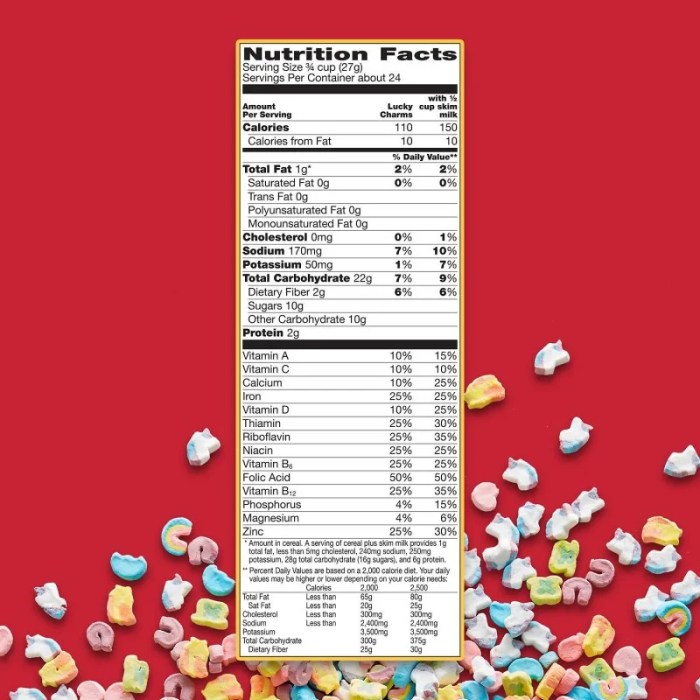Sugar Content in Lucky Charms

Nutrition facts lucky charms – Let’s dive into the sugary sweetness of Lucky Charms and explore just how much sugar is packed into those magically delicious marshmallows and oat pieces. We’ll compare it to other cereals and discuss the potential health implications, particularly for children.
Lucky Charms, with its colorful charms and enticing marshmallow bits, is a popular breakfast cereal, especially among children. However, its sweetness comes at a cost – a significant amount of sugar. Understanding the sugar content and its potential effects is crucial for making informed choices about breakfast cereals.
Sugar Content Comparison Across Cereals
To understand Lucky Charms’ sugar content in context, let’s compare it to other popular breakfast cereals. The following table presents data on sugar content per serving, expressed in both grams and as a percentage of the recommended daily value (%DV). Note that serving sizes vary between cereals, impacting the overall sugar intake.
| Cereal Name | Sugar per Serving (grams) | Sugar per Serving (% Daily Value) | Serving Size |
|---|---|---|---|
| Lucky Charms | 12g | 24% | 1 cup (28g) |
| Frosted Flakes | 10g | 20% | 1 cup (28g) |
| Cheerios | 1g | 2% | 1 cup (30g) |
| Shredded Wheat | 0g | 0% | 1 biscuit (29g) |
Note: These values are approximate and may vary slightly depending on the source and specific product variations. Always refer to the nutrition label on the cereal box for the most accurate information.
Health Implications of High Sugar Consumption in Children
The high sugar content in Lucky Charms, as evident in the comparison above, raises concerns about its potential health implications, especially for children. High sugar intake is linked to several health problems, including weight gain, type 2 diabetes, tooth decay, and increased risk of heart disease later in life. A single serving of Lucky Charms provides a substantial portion of the recommended daily sugar intake for children, potentially contributing to excessive sugar consumption if eaten regularly.
For example, a child consuming a bowl of Lucky Charms daily might easily exceed their recommended daily sugar intake, leading to an increased risk of developing these health issues. This is particularly concerning because children’s bodies are still developing and are more vulnerable to the negative effects of excessive sugar.
Visual Representation of Sugar Proportion
Imagine a circle representing the recommended daily sugar intake for a child. This circle is divided into sections. A large section, perhaps representing 24%, is colored brightly to visually depict the sugar content in a single serving of Lucky Charms. The remaining sections of the circle are much smaller and less brightly colored, showing the remaining amount of sugar a child can consume throughout the day.
This visual clearly demonstrates the significant proportion of sugar contained within just one serving of Lucky Charms, highlighting the need for moderation.
Marketing and Consumer Perception

Lucky Charms, with its magically enticing marshmallows and whimsical leprechaun mascot, is a masterclass in targeted marketing towards children and families. The brand’s enduring success hinges not just on its taste, but on a carefully crafted image that transcends mere breakfast cereal.The marketing strategies employed by General Mills to sell Lucky Charms effectively leverage the power of childhood fantasy and parental nostalgia.
So, you’re checking out the nutrition facts for Lucky Charms? Pretty sugary, right? To compare, you might want to look at the king size kit kat nutrition facts – those are pretty intense too. Then you can really appreciate just how much sugar is in that Lucky Charms marshmallow.
Bright, colorful packaging featuring the iconic Lucky the Leprechaun immediately grabs attention on supermarket shelves. Advertising campaigns, historically, have focused on creating a sense of fun and excitement, often showcasing children happily enjoying the cereal, associating it with joy and positive experiences. This association, subtly reinforced over decades, deeply influences consumer perception.
Marketing Strategies Targeting Children and Families
General Mills’ marketing expertly targets two key demographics: children and their parents. For children, the focus is on the whimsical elements – the magical marshmallows, the playful leprechaun, and the overall sense of fun and adventure. This is achieved through cartoon advertising, vibrant packaging, and often, tie-ins with children’s entertainment properties. For parents, the marketing subtly emphasizes the “treat” aspect, positioning Lucky Charms as a permissible indulgence, a special breakfast option rather than an everyday staple.
This carefully avoids direct confrontation with the cereal’s nutritional profile, allowing parents to rationalize its consumption as an occasional treat. The use of familiar characters and themes creates a sense of comfort and familiarity, making parents more likely to purchase the product.
Influence on Consumer Perception of Nutritional Value
The marketing strategies significantly impact consumer perceptions of Lucky Charms’ nutritional value. The focus on fun and fantasy overshadows any serious discussion of the cereal’s high sugar content. The association with childhood joy and positive experiences makes parents less likely to scrutinize the nutritional information, leading to a perceived disconnect between the product’s fun image and its less-than-ideal nutritional profile.
The marketing successfully positions Lucky Charms as a “treat,” minimizing the perceived need for it to be nutritionally balanced. This is a classic example of how effective marketing can influence consumer behavior and override rational decision-making, particularly when it comes to products aimed at children.
Hypothetical Marketing Campaign for a Healthier Version
A healthier version of Lucky Charms could be marketed with a campaign emphasizing “magical nutrition.” The packaging could feature the same beloved leprechaun, but with a more vibrant, healthy-looking design. The advertising could focus on the inclusion of whole grains, added vitamins, and reduced sugar, highlighting the benefits of a balanced breakfast. Instead of solely relying on fun and fantasy, the campaign could incorporate elements of education and empowerment.
For example, commercials could show children participating in active play after enjoying the healthier cereal, associating it with energy and well-being. The slogan could be something like, “Lucky Charms: Now with a sprinkle of magic and a boost of goodness!” This approach would subtly shift the focus from pure indulgence to a healthier, yet still enjoyable, breakfast option.
This campaign would acknowledge the existing brand recognition and consumer loyalty while introducing a positive message about healthier eating habits.
Ingredients and Processing
Lucky Charms, those magically delicious oat-based cereal pieces, are a product of a complex manufacturing process involving a blend of ingredients, some contributing to their appealing taste and texture, others potentially impacting their nutritional profile. Understanding these ingredients and their processing is key to a complete picture of the cereal’s overall health implications.
The primary ingredients in Lucky Charms are oats, sugar, corn syrup, dextrose, salt, and a variety of artificial colors and flavors that create the iconic marshmallow charms. These ingredients, while contributing to the sensory appeal of the cereal, also contribute significantly to its sugar and processed carbohydrate content. The high sugar content, in particular, raises concerns about potential negative health effects such as weight gain, increased risk of type 2 diabetes, and dental problems, especially with regular consumption.
The artificial colors and flavors are also a point of contention for some consumers, with concerns about potential long-term health effects although current scientific consensus is inconclusive. The presence of whole grain oats, however, offers a small nutritional benefit, providing some fiber. However, this benefit is significantly overshadowed by the other ingredients.
Ingredient Breakdown and Health Implications, Nutrition facts lucky charms
Let’s delve deeper into the specific ingredients and their potential impact. The significant amount of added sugar is a major concern. This sugar comes in various forms, including sucrose (table sugar), corn syrup, and dextrose, all contributing to the cereal’s high glycemic index. A high glycemic index means the cereal causes a rapid spike in blood sugar levels, which can have negative consequences for metabolic health.
The artificial colors and flavors, while generally considered safe within regulatory limits, remain a source of debate due to some studies suggesting potential links to hyperactivity in children, though more research is needed to definitively establish a causal relationship. The presence of whole grain oats, while beneficial for fiber intake, is often insufficient to counteract the negative effects of the other ingredients.
Manufacturing Process and Nutritional Impact
The manufacturing process of Lucky Charms involves several steps, starting with the preparation of the oat base. This likely involves processes like rolling, flaking, and possibly toasting. The marshmallows are produced separately, involving a process of cooking a mixture of sugar, corn syrup, gelatin, and other ingredients. These processes, especially the extensive use of refined sugars and high heat, can alter the nutritional profile of the ingredients, potentially reducing the bioavailability of certain nutrients and potentially increasing the formation of harmful compounds.
For example, high heat processing can reduce the nutritional value of the oats and increase the formation of acrylamide, a potential carcinogen.
Discrepancies Between Ingredient List and Nutritional Facts Panel
While both the ingredient list and the nutritional facts panel provide information about Lucky Charms, they don’t always tell the whole story. The ingredient list, ordered by weight, shows the relative proportions of each ingredient. However, it doesn’t always clearly indicate the specific types of sugar or the presence of processed ingredients. The nutritional facts panel provides information on macronutrients like carbohydrates, sugars, fats, and proteins, along with vitamins and minerals.
However, it doesn’t reveal the processing methods or the potential formation of harmful compounds during manufacturing. A discrepancy might arise if, for example, the nutritional panel lists “sugar” without specifying the different types of sugars used, thus obscuring the high amount of added sugars compared to naturally occurring sugars.
Essential FAQs: Nutrition Facts Lucky Charms
Are Lucky Charms suitable for adults?
Yeah, adults can eat them, but it’s high in sugar so it’s not exactly ideal for a daily breakfast. Think of it as an occasional treat.
What are the main ingredients in Lucky Charms?
Oats, sugar, corn syrup, marshmallows, and various other bits and bobs – check the packaging for the full list, mate.
Can I use Lucky Charms in baking?
Sure, but be mindful of the added sugar – you might need to adjust other sweeteners in your recipe accordingly.
Are there any gluten-free alternatives to Lucky Charms?
Plenty of other cereals offer similar fun, but gluten-free. Check the labels carefully.

